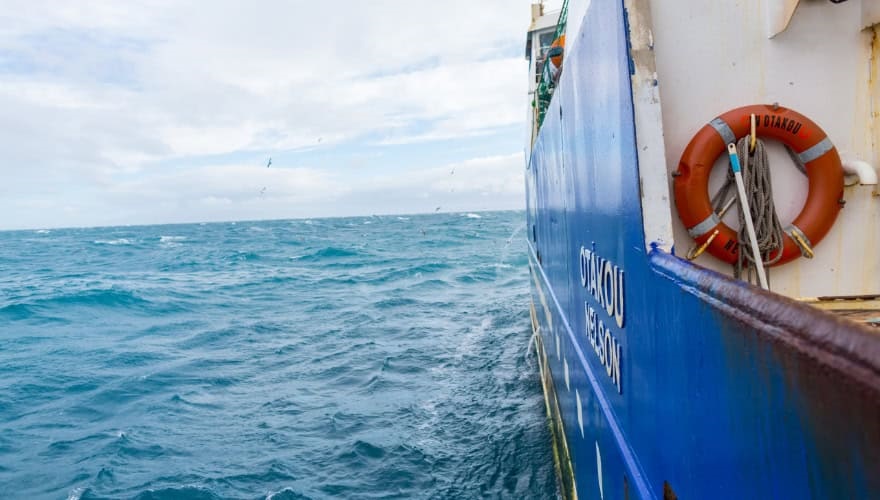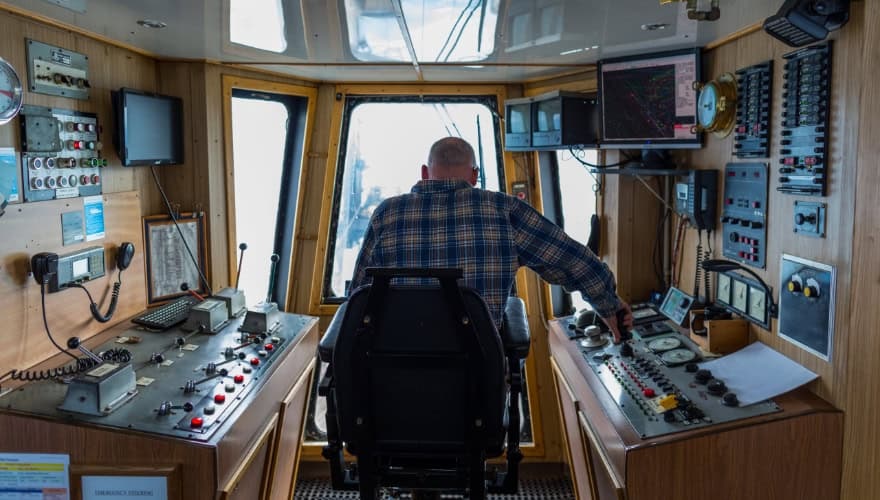
When the winter snow settles heavy over New Zealand’s Southern Alps, many of the country’s most experienced deep-sea fishermen and women take to the seas pumped with enthusiasm – it’s hoki season!
This is no winter ocean holiday. It is cold, the seas are rough, and the workdays are long. But for the crew of New Zealand’s commercial deep-sea fleet, this is what fishing is all about. Big days, great catches.
When the icy waters flow, so do the hoki Every winter, hoki move around New Zealand waters away from their traditional feeding grounds as they seek out their favourite spawning sites. One of the world’s most sustainable white fish, hoki can travel over 1,200km to spawn. They seek out cooler waters, particularly those fresh with winter snow from glacial rivers that flow out to the Tasman sea, off New Zealand’s West Coast. They also travel even further south, around the Campbell Plateau and in the fast-flowing waters of the Cook Strait and Chatham Rise.
This winter period in New Zealand is known as hoki season. Most of the annual quota for hoki is caught from around June to September. New Zealand stands proud as the first country in the world to establish a Quota Management System (QMS), back in 1986. For hoki, the total annual catch permitted in New Zealand’s waters is less than 10% of the adult population of the fish.

A change in the waters
Some see the crew of fishing vessels simply as fishers, catching fish. But they do so much more. While they are tasked with providing food for people all around the world, in doing do so, they act as environmentalists. Any good farmer or grower has an intimate understanding of their environment and a good fisher is no different. Their livelihood depends on it.
A couple of years back, the skippers and their crew were noticing a change. It was 2018, and in the West Coast fishery they were seeing smaller marks of hoki than they would expect. It’s not a change those tasked with caring for the oceans would ignore.
The reasons were unclear and contradicted what was seen in the government’s stock assessment and modelling at the time. However, the industry came together and agreed to reduce their catch that year by 20,000 tonnes, taking the annual catch limit from 150,000 tonnes down to 130,000 tonnes. The following year industry advised government they wished to set in place a further reduction of 15,000 tonnes, taking the annual catch limit to 115,000 tonnes. The Fisheries Minister agreed, and, in his formal review of the fishery, reduced the TACC (Total Allowable Commercial Catch) to 115,000 tonnes. Industry has not ruled out taking further conservative measures should they consider these to be necessary.
As well as reducing catch, the industry worked to collect more biological data from catches and has reduced fishing pressure on juvenile and spawning hoki. They have also contracted scientists to undertake genetic analyses of hoki to determine their stock structure. There is very little knowledge on this, yet it is critical to understand in order to manage this valuable resource.

Observations and evidence
This proactive response by the people out on the water has proven to be a smart move. It allows time for those doing the science and determining catch limits to catch up. Evidence is vital for understanding and managing fisheries, but observations from those in the fishery are equally important in sustainable fishing too. While not yet clear, it is thought the reduced number of hoki in their usual winter stomping grounds may relate to the higher temperatures seen in these waters in the past couple of years.
“This conservative approach will have a positive influence on the hoki fishery and give it the strongest future.”
COO of Sanford
“It is possible that changing environmental conditions have created a situation where fewer hoki are in condition for spawning. We know they prefer cooler water for spawning,” says Charles Heaphy of Sealord, New Zealand’s largest deep-sea fishing company.
“What is very encouraging is just this season we have seen improvements in the abundance of hoki coming to spawn. Hoki are a fast-growing species and their abundance is likely to be increasing as a result of fishery management actions as well as favourable changes in their environment.” Charles is an environmental scientist and works alongside others in Fisheries New Zealand (a division of the New Zealand Ministry for Primary Industries) and NIWA (National Institute of Water and Atmospheric Research – a New Zealand Crown Research Institute) in the scientific assessment of New Zealand fisheries.

From New Zealand to the world
A robust hoki population supports a growing market for hoki all around the globe. Its delicately flavoured white flesh flakes easily, and is well suited to a wide variety of cooking styles. It has a fairly high fat content, making it a succulent, moist fish.
Hoki has been a family favourite in New Zealand for years. It’s a regular choice in fish ‘n’ chip shops dotted all around country and a popular supermarket item - most commonly purchased in frozen format, already battered or crumbed. During the recent Covid-related lockdowns, supermarket freezers around New Zealand were left empty as people rushed to stock their home freezers with hoki fillets carrying the MSC blue fish tick – valued as a nutritious, affordable, and easy dinner option.

“Our global goal is for 100% of wild-caught fish to be from verified sustainable sources. New Zealand hoki is an approved species for McDonald's' Filet-o-Fish – it has a mild taste, flaky flesh, and carries the MSC stamp of approval from the fishery.”
Head of Communications, McDonald's New Zealand
Kiwis eat more than 5 million hoki fillets in Filet-o-fish burgers every year!
McDonalds is not the only quick serve restaurant (QSR) dishing up the fish in a burger. New Zealand hoki features in many QSR outlets around Europe, and it’s a popular choice for large scale caterers in schools and hospitals. The Polish market is now one of the largest for New Zealand hoki, where it can be found in supermarket freezers, and served up with fries at popular seaside holiday spots.
Slightly less well-known than the Filet-o-fish is the nori bento box – a traditional lunch box in Japan sold in convenience stores and takeaway outlets. Hoki is a popular feature in these bento boxes, usually served as a panko crumbed fillet, with nori (seaweed), rice, and other side dishes. Hoki is also building a reputation in Japan in institutional catering, feeding many people in schools, hospitals, company catering, and care homes. In these places, menus are designed by nutritionists, who like to include pan-fried natural hoki fillets in the menu for their high nutritional value and lack of bones.
Overall, hoki exports are worth NZ$230 million (US$150 million) to the New Zealand economy. Europe is the largest consumer market, followed by Australia. While smaller, both Japan and China are growing markets as more seafood lovers become familiar with the fish. China is also a fairly large market for further processing, with fish on-sold to customers in Europe and Japan.
High value – no waste
The industry has taken a clear 'nose to tail' approach with hoki – eliminating waste entirely. Most fishing vessels will process the freshly caught hoki on board, so it is snap frozen at sea. A team of skilled filleters remove the fillets, which are packed directly into boxes and frozen, ready for export as soon as the vessel docks back at port. The remaining skin, bones, and heads are processed into fish meal. Hoki livers are used to make fish oil.
More recently, New Zealand hoki has made its way into high end skin care, as Sanford collaborated with Plant and Food Research and Revolution Fibres to produce wrinkle reducing skin masks made from collagen extracted from hoki skin. Branded ‘Activlayr’, the nanofibre products are fetching a high price in China and were recently successfully launched into South Korea.

Kaitiaki – guardians of the ocean
In 2001, the New Zealand hoki fishery became the first white fish fishery in the world to achieve certification to the MSC Fisheries Standard for its sustainable management practices. This independent verification added an additional layer of confidence for customers seeking fish from sustainable sources.
“Sustainability is increasingly important for the consumer,” says Doug Paulin, CEO of Sealord. “People want to know where and how their fish are caught, and we support that, 100%.”
“We are Kaitiaki (‘guardians’) of the ocean. It is important to all of us that we care for our oceans and look after the supply of fish for our grandchildren and future generations.”

For Gavin Knight, skipper of Sealord’s vessel Otakou, fishing is a lifestyle job.
“We are out here every day - rain, hail, or shine. Hoki is New Zealand’s most prevalent species and our biggest export fish. It helps keep our country going day-by-day. And it has to be able to keep supporting the industry and our people long after we are gone. So, we are all keen to do our bit to keep the fisheries healthy.”
The unwavering focus on sustainability for New Zealand hoki has seen the fishery meet the MSC Fisheries Standard for a third time, in 2018. George Clement is chief executive of Deepwater Group, an organisation which represents New Zealand deepwater quota owners and works in partnership with Fisheries NZ and scientists. He says that it’s all about working with the future in mind.
“We and the MSC are aligned to achieving the same long-term, sustainable solutions,” says Clement. “We are sourcing natural seafood, while looking after the resources and the ocean ecosystems that support these. The MSC has the world’s best scientific standards for sustainable fisheries, against which our performance is measured. 70% of the seafood from our deepwater fisheries, including hoki, are now certified to the MSC Fisheries Standard. These fisheries support whanau (extended family), iwi (kinship groups), whole communities, and New Zealand’s economy. We remain committed to ensuring this continues far into the future.”

But right now, from one MSC-certified fishery near the bottom of the earth, a family will be tucking into their Friday night fish ‘n’ chips, while another on the far side of the world will be enjoying a burger. And someone, somewhere in between, is smoothing out their wrinkles. Meanwhile, the skippers, with their crew, are still out there, working hard and keeping a watchful eye on where it all begins.
The Marine Stewardship Council is an international non-profit on a mission to end overfishing and restore fish stocks for future generations.
We want future generations to be able to enjoy seafood and oceans full of life, forever.
Read more of our inspirational sustainable seafood stories about the passionate people taking care of our oceans.
Read more sustainable seafood stories
All images © Jason Thomas for the Marine Stewardship Council unless otherwise stated

